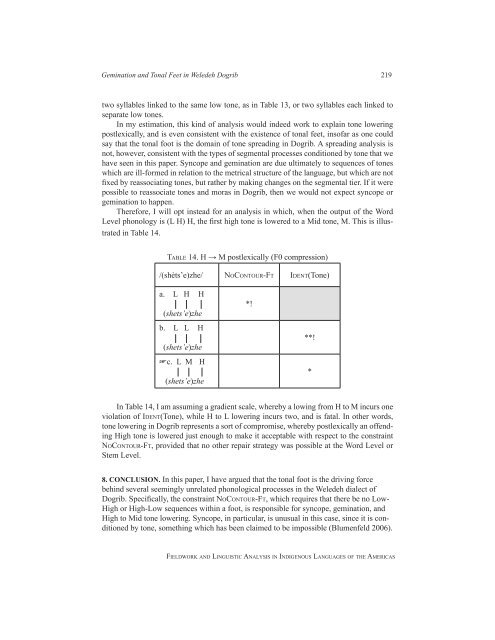Fieldwork and Linguistic Analysis in Indigenous ... - ScholarSpace
Fieldwork and Linguistic Analysis in Indigenous ... - ScholarSpace
Fieldwork and Linguistic Analysis in Indigenous ... - ScholarSpace
Create successful ePaper yourself
Turn your PDF publications into a flip-book with our unique Google optimized e-Paper software.
Gem<strong>in</strong>ation <strong>and</strong> Tonal Feet <strong>in</strong> Weledeh Dogrib 219<br />
two syllables l<strong>in</strong>ked to the same low tone, as <strong>in</strong> Table 13, or two syllables each l<strong>in</strong>ked to<br />
separate low tones.<br />
In my estimation, this k<strong>in</strong>d of analysis would <strong>in</strong>deed work to expla<strong>in</strong> tone lower<strong>in</strong>g<br />
postlexically, <strong>and</strong> is even consistent with the existence of tonal feet, <strong>in</strong>sofar as one could<br />
say that the tonal foot is the doma<strong>in</strong> of tone spread<strong>in</strong>g <strong>in</strong> Dogrib. A spread<strong>in</strong>g analysis is<br />
not, however, consistent with the types of segmental processes conditioned by tone that we<br />
have seen <strong>in</strong> this paper. Syncope <strong>and</strong> gem<strong>in</strong>ation are due ultimately to sequences of tones<br />
which are ill-formed <strong>in</strong> relation to the metrical structure of the language, but which are not<br />
fixed by reassociat<strong>in</strong>g tones, but rather by mak<strong>in</strong>g changes on the segmental tier. If it were<br />
possible to reassociate tones <strong>and</strong> moras <strong>in</strong> Dogrib, then we would not expect syncope or<br />
gem<strong>in</strong>ation to happen.<br />
Therefore, I will opt <strong>in</strong>stead for an analysis <strong>in</strong> which, when the output of the Word<br />
Level phonology is (L H) H, the first high tone is lowered to a Mid tone, M. This is illustrated<br />
<strong>in</strong> Table 14.<br />
table 14. H → M postlexically (F0 compression)<br />
/(shèts’e)zhe/ nocontour-ft ident(Tone)<br />
a. L H H<br />
(shets’e)zhe<br />
b. L L H<br />
(shets’e)zhe<br />
☞c. L M H<br />
(shets’e)zhe<br />
*!<br />
In Table 14, I am assum<strong>in</strong>g a gradient scale, whereby a low<strong>in</strong>g from H to M <strong>in</strong>curs one<br />
violation of ident(Tone), while H to L lower<strong>in</strong>g <strong>in</strong>curs two, <strong>and</strong> is fatal. In other words,<br />
tone lower<strong>in</strong>g <strong>in</strong> Dogrib represents a sort of compromise, whereby postlexically an offend<strong>in</strong>g<br />
High tone is lowered just enough to make it acceptable with respect to the constra<strong>in</strong>t<br />
nocontour-ft, provided that no other repair strategy was possible at the Word Level or<br />
Stem Level.<br />
8. CONCLUSION. In this paper, I have argued that the tonal foot is the driv<strong>in</strong>g force<br />
beh<strong>in</strong>d several seem<strong>in</strong>gly unrelated phonological processes <strong>in</strong> the Weledeh dialect of<br />
Dogrib. Specifically, the constra<strong>in</strong>t nocontour-ft, which requires that there be no Low-<br />
High or High-Low sequences with<strong>in</strong> a foot, is responsible for syncope, gem<strong>in</strong>ation, <strong>and</strong><br />
High to Mid tone lower<strong>in</strong>g. Syncope, <strong>in</strong> particular, is unusual <strong>in</strong> this case, s<strong>in</strong>ce it is conditioned<br />
by tone, someth<strong>in</strong>g which has been claimed to be impossible (Blumenfeld 2006).<br />
fieldwork <strong>and</strong> l<strong>in</strong>guistic analysis <strong>in</strong> <strong>in</strong>digenous languages of the americas<br />
**!<br />
*

















